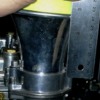quote:
Originally posted by mike the snake:
I AM tempted to take the top off and inspect my lifters while my engine is down, while waiting on new rockers.
If I do, you can bet I'll be getting busy with my grinder and cut a big hole in that plate, and make a bolt on cover so I can look inside by simply removing the cover off the center plate.
quote:
Originally posted by PanteraDoug:
It never occurred to me before that I remember but the separate center plate could have been cut narrower to permit it to be used as an access cover into the lifter gallery?
MTS's situation would be a good illustration of why it could be useful.
Pet Shop balls? Those are big and hairy. Strange?
https://www.youtube.com/watch?v=_W-fIn2QZgg
If that is the case, might I suggest, mark on the plate where the manifold meets it.
Take the plate off and cut it leaving the lines you marked on the plate.
Fit it back in a way that you can seal it to the edges (l left and 1 right) of the intake manifolds with silicone.
You might want to also consider adding two Allen socket head bolts to each end that go through the plate and thread into the edges of the block.
You aren't going to see much through one hole through the plate and there isn't much point in making it into swiss cheese?
This way you can periodically remove the plate to examine and or change the lifters?
It's a lot faster than pulling off the entire intake manifold and disturbing all of the throttle bodies and linkages.
You actually can cut that plate on a table saw with a triple carbide tipped tooth blade very easily...but don't tell anyone I said that ok?












